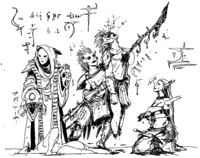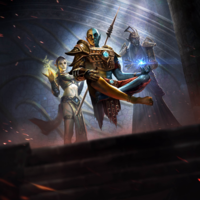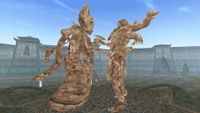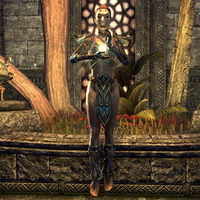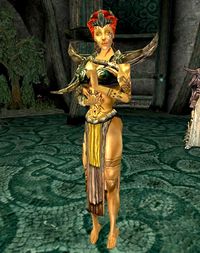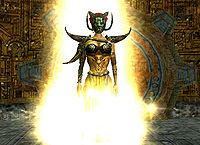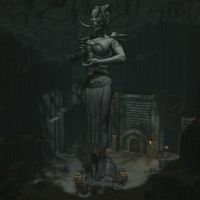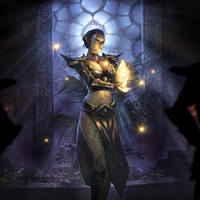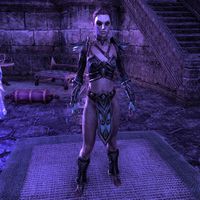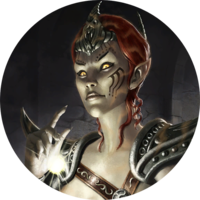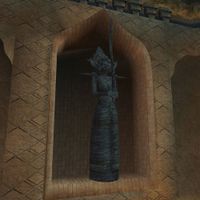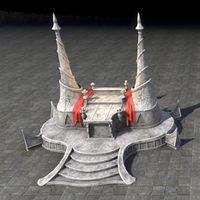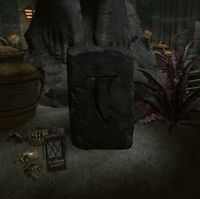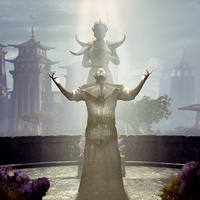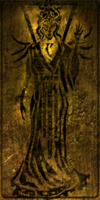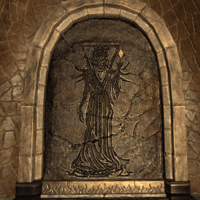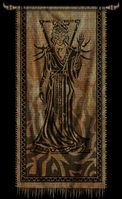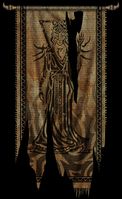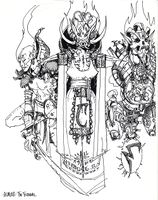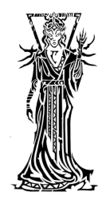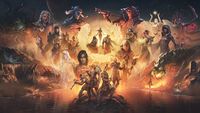Lore:Almalexia
This article is about the god. For the city, see Almalexia (city).
- "Ayem threw down her cloak and became the Face-Snaked Queen of the Three in One. Those that looked upon her were overcome by the meanings of the stars." —The 36 Lessons of Vivec, Sermon 36
| Lady Almalexia | |||
|---|---|---|---|
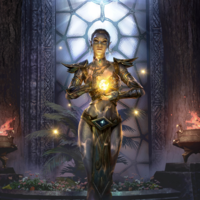 Lady Almalexia
Lady Almalexia |
|||
| Race | Chimer | Gender | Female |
| Born | 1st Era |
||
| Died | 3E 427 Clockwork City |
||
| Resided in | Mournhold | ||
| Appears in | Tribunal, ESO, Legends | ||
Almalexia, also known as Almalexia the Lover[1], Almalexia the Warden,[2] and Ayem,[3] was one of the three God-Kings who constituted the Tribunal, or Almsivi, along with Vivec and Sotha Sil. She was very popular among the Dunmer, who called her "Healing Mother", "Lady of Mercy", "Mother Morrowind"[4] and "Sacred Lady"[5]. They knew her as the source of compassion, sympathy, and forgiveness, the protector of the poor and weak, and the patron of teachers and healers.[4] She resided in the temple city of Mournhold within the city of Almalexia, the capital of Morrowind, and was closely associated with House Indoril.
She was also the most personable of the Tribunal and was well known for walking among her people. As a mortal, she was the wife of Lord Indoril Nerevar, First Councilor of Resdayn. As a living god, she became the Consort of Lord Vivec,[2] who associated her with the stars.[3] Her other titles include Face-Snaked Queen of the Three in One[3] and Most Blessed Lady Almalexia.[2]
Originally the counselors to Nerevar, the Tribunal came to power among the Dunmer following her husband's death at the Battle of Red Mountain circa 1E 700. Before his death, they swore oaths to Nerevar upon Azura that they would never use the Tools of Kagrenac on the Heart of Lorkhan in order to steal its divine essence for themselves. A few years later, Almalexia and her fellow Tribunes broke that oath to become living gods. This led to the transformation of the Chimer into the Dunmer, and the Tribunal became their immortal protectors, leaders, and gods.[6][7] The truth of how they gained their divinity was covered up; according to the Heirographa, the orthodox public teachings of the Tribunal Temple, their divinity was a more spontaneous result of their supernatural virtue, discipline, wisdom, and insight.[8][9]
The power of Almalexia and the other Tribunes declined during their struggle with Dagoth Ur throughout the Third Era, and Almalexia eventually lost her mind along with her power. During the time of the Nerevarine Prophecies in 3E 427, she killed Sotha Sil and then died in a failed attempt to kill the Nerevarine.[10]
Contents
History[edit]
Little is known of Almalexia before she became Nerevar's wife. Temple myth holds that on Mount Assarnibibi, Molag Bal oversaw the ninety-nine lovers of Boethiah who gave birth to her.[11] She hailed from one of the Great Houses of Morrowind.[12] Vivec's prose suggests she was already a ruler when she met Nerevar, who was working as a guard for a merchant caravan at the time.[3] Though Nerevar was a generation older than her,[13] they eventually got married. The Dwemer king Dumac, who had become Nerevar's close friend, presented them with twin blades of the highest Dwemeri craftsmanship. Almalexia's was known as Hopesfire.[14] During the times of Nerevar she was advised by the Shouts, a Chimeri guild of counselors.[15] Sources conflict on how her husband met his demise. Most attribute it to wounds he received during the Battle of Red Mountain. The Ashlanders, who rejected Tribunal worship, believe that Almalexia and her fellow Tribunes murdered her husband so he would not interfere with their plan to take divine power.[6][16][17]
As soon as the Tribunal stole power from the Heart, Azura appeared and cursed them. The Daedric Prince issued the prophecy that the Nerevarine would return to punish them for breaking their oaths. When Sotha Sil waved off her omens, the Dunmer were created, and Azura gave a final prophecy: that the Dunmer would share the Tribunal's fate until the end of time. Though confused at first, the Dunmer (with the exception of Ashlanders, who know her as the "Mad Wife")[18] did come to accept the Tribunal as their new gods.[6] Theological concerns gave rise to the idea of the "Anticipations", the "Good Daedra" the Chimer had worshipped before the Tribunal's apotheosis (so while the Tribunal had once been mortal, and non-existent before that, their Anticipations were said to have guided the Chimer in their stead). The Good Daedra are those Princes of Oblivion who apparently acknowledged the Tribunal's authority over the Dunmer (as opposed to the Bad Daedra, spirits who did not accept the Tribunal). The Anticipation of Almalexia was Boethiah, Prince of Plots.[17][19][20][21]
The Lady of Mercy[edit]
Almalexia wielded her divine power for the protection and benefit of the Dunmer for thousands of years. Sotha Sil largely remained aloof and mysterious, but Almalexia and Vivec both took very active roles in leading their people throughout the First and Second eras. Her acts of amazing power and kindness are countless. Her blessing was said to do extraordinary things, like protect a person infected with Corprus from suffering the disease's effects.[11] Saint Felms the Bold is said to have been inspired by the voice of Almalexia in his head.[11] The Hands of Almalexia were her personal guard, and were often called the greatest warriors in all of Tamriel.[10] Like Vivec, she wrote extensively, though she focused on children's fables and similar works meant to nurture the morality of her people rather than Vivec's more cerebral, spiritual guidance.[1][3][22][23]
In 1E 2920, Mehrunes Dagon destroyed the city of Mournhold. After an epic battle, he was defeated by Almalexia and Sotha Sil. This was portrayed in the historical fiction 2920, The Last Year of the First Era, which also suggested Almalexia foresaw in her dreams the end of the Four-Score War, as well as the end of the Reman Dynasty.[24]
In 2E 572, Almalexia fought alongside Wulfharth, also known as the Underking, against Ada'Soom Dir-Kamal during an Akaviri invasion of northern Tamriel.[25][26] Sources seem to disagree on certain aspects of this conflict. Mysterious Akavir treats Morrowind as the target of the Akaviri invasion, though Skyrim was apparently the Akaviri's initial target. The Arcturian Heresy claims Almalexia was the one who summoned the Underking to fight alongside the Tribunal (even though in life, he had been one of their greatest enemies). Jorunn the Skald-King contradicts this, crediting the Greybeards with summoning the Ash-King. The book also claims that Dir-Kamal's army was crushed by several Tamrielic military forces, not just the Dunmer army under Almalexia's command, and that this occurred at a place called Stonefalls. The other sources do not mention the Nordic or Argonian forces which played roles, and Mysterious Akavir says Dir-Kamal was defeated at Red Mountain.
Following the Akaviri invasion, Almalexia was a strong supporter of the formation of the Ebonheart Pact. It was she who convinced the Great Houses (sans Telvanni) to join the Pact. During the Alliance War of 2E 582, Deshaan was threatened by a cult known as the Maulborn, who sought to topple the Tribunal and return the Dunmer to Daedra worship. They were led by Magistrix Urili Vox, once a handmaiden of Almalexia who turned against her following her son's execution. The insurgents were ultimately put down.[27]
The Return of Dagoth Ur[edit]
In 2E 882, Dagoth Ur awoke beneath Red Mountain. The former Lord High Councilor of House Dagoth had been thought dead, but through unknown means, he had actually forged his own connection to the Heart of Lorkhan, drawing divine power from it just like the Tribunal did, and was merely sleeping. When the Tribunal arrived at the mountain for their annual ritual bath to replenish their power, Dagoth Ur and his minions attacked them and drove them away, decisively cutting them off from access to the Heart.[28] The Tribunal would spend almost four hundred and fifty years, virtually all of the Third Era, slowly losing ground to him. Their preoccupation with what had become the Devil Incarnate for the Dunmer people is perhaps one reason why Vivec avoided war with Tiber Septim and signed the Armistice, making Morrowind an autonomous province of the Third Empire.[29]
With the advent of Imperial rule in Morrowind, Mournhold became a town of two minds: there was the monarchy led by the Imperial-appointed king, and the Temple led by Almalexia. While there has been no open hostility between the two, there were always undercurrents of tension.[30] The power mainly stayed with the Temple, and the monarchy seemed to acquiesce to this reality (the king was, after all, the vassal ruler of the Empire, and Morrowind had retained its autonomy under the terms of the Armistice).[10][29] However, many feared the violence that would ensue should the king ever attempt to challenge Almalexia's authority.[10]
The Tribunal made seasonal campaigns to Red Mountain, and slew Dagoth Ur and his kin, the ash vampires, though the Heart always revived them in time. Almalexia had always had a tendency to brood, and without access to the Heart of Lorkhan, her divinity ebbed.[13] This weighed heavily on her,[13] and she became a harsher, more unsympathetic patron.[10] She stopped walking among her people around 3E 377.[31]
When the Tribunal realized they could not defeat Dagoth Ur, they built the Great Ghostfence to contain him around 3E 417.[13][32] This seemed to work, until Almalexia and Sotha Sil were attacked during a campaign and lost two of the Tools of Kagrenac, Sunder and Keening.[13] Though Vivec rescued his fellow Tribunes, the Tools were lost, and both the real impact of their loss and what it signified proved crippling.[10] Almalexia and Vivec stopped communicating. Vivec grew concerned that she would pose a danger to herself and others, and might even try to harm him.[13] Almalexia ceased appearing in public altogether,[32] and the incident was the last known time Sotha Sil was seen alive. Vivec was left to spearhead the fight against Dagoth Ur alone.[28][33] The Tribunal was undone.
The Death of Almalexia[edit]
- "She believes her tales implicitly. As does everyone else. Her capacity for deception appears limitless. She sows lies like a master gardener sows seeds, and the harvest of trust and adulation is breathtaking in scope. ... Almalexia does what she does because she cannot do otherwise. It will not end well. But then, even the best endings rarely bring joy."— Sotha Sil
Almalexia had changed. Those few who still saw her noticed that she had begun to act more like a warrior queen than the Lady of Mercy.[34] Those closest to her knew that she had turned into a wholly different person, one who was obsessed with maintaining her image at the expense of everything else.[35] In lieu of divine power, Almalexia exploited her knowledge of ancient and powerful relics to inflict terrible punishments on her people for what she perceived as their lack of faith, such as by using Dwemeri machinery to cover her capital city in ash storms. But in her madness, she concocted a new goal: to become the one true god of the Dunmer, uniting all of her people under one faith and authority - and destroying any who interfered.[14] When the Nerevarine came to Mournhold after Dagoth Ur's fall in 3E 427, Almalexia sought to trick, entrap, and destroy him as part of this plot. She first turned on Sotha Sil and slew him in his Clockwork City, then unleashed its mechanical inhabitants into her own city in order to frame her old friend. Her ruse lured the Nerevarine to Sotha Sil's legendary home, where she hoped that the reincarnation of her husband would be killed by the inhabitants. When the Nerevarine persevered, Almalexia tried to finish the job herself. But her powers failed her, and she died at the Nerevarine's hand in the Clockwork City.[10] Though Almalexia would call Vivec a fool in her final hours,[14] Vivec, the last remaining Tribune,[36] only expressed pity for his fallen, deranged lover.[13] He later retrieved her body, and interred her and Sotha Sil in the proper Velothi fashion.[UOL 1]
According to Azura, the death of Almalexia was a boon for all of Morrowind, even if the people did not understand it at the time. The Daedric Prince professed that the Lady of Mercy would have betrayed the Dunmer as surely as she had betrayed all those she loved, for this was her true curse.[36] By 3E 432, the Empire reported that Almalexia, Dagoth Ur, Sotha Sil (and possibly Vivec) were destroyed in the "Nerevarine's fury" and that the Nerevarine likewise had vanished.[37]
Continued Worship[edit]
Despite her death, many Dunmer—including most of the Redoran and the Temple faithful—continued to believe for many years that Almalexia still lived, and considered it heretical to suggest otherwise.[2][UOL 2] Support for the Temple's worship of Almalexia, Sotha Sil, and Vivec gradually weakened over the years, and it was not until after the Red Year in 4E 5 that all three of the Tribunes were now widely believed dead or disappeared, causing a long-brewing schism within the ranks of the Temple priesthood to erupt. The former Dissident Priests were in full control of the Temple hierarchy in the aftermath, with Tribunal loyalists either purged or recanted, and the newly dubbed "New Temple" now declared the worship of the Tribunes a result of misguided teaching. The Dunmer returned to the veneration of Boethiah, now called one of the "Reclamations", and managed to make their way without their Healing Mother watching over them. Almalexia is still remembered and honored as one of the greater saints of the Dunmeri faith,[38] but not one who was ever supposed to be one of the cornerstones of the religion.[39] By 4E 201, the last vestiges of Almalexia's marks were gone from Mournhold.[40]
Despite the majority of the Dunmer people turning away from Almalexia worship, the Goddess was still revered by certain sects. These devotees were regarded as heretics by the New Temple and were persecuted for their beliefs.[41] One cult of Almalexia worshippers constructed a hidden temple in a cave on Solstheim known as Ashfall's Tear, just north of Raven Rock. The cultists raised a giant statue to the Goddess and planned to use old propaganda to restore widespread Tribunal worship.[42][43] These devotees counted several Hands of Almalexia among their ranks, a tradition which survived the Goddess's death.[44] Circa 4E 201, the Last Dragonborn was alerted to the cult's existence, although it is unknown if the Dragonborn aided the cult or destroyed it.[42]
Personal Life[edit]
Personality[edit]
Almalexia showed a great amount of compassion and sympathy for her people, and was known as a protector of the poor and weak.[2] She also had exceptional political skills.[24] Upon seeing Mournhold burned and squandered, she wept, and turned her heart to "molten brass", becoming furious towards Dagon. Sotha Sil sealed the memory away in his great mnemonic planisphere as a reminder of her love's high price.[45]
Combat Prowess[edit]
Almalexia was a skilled and powerful combatant. It is said she was even capable of defeating Vivec in single combat if such a duel were to have occurred.[UOL 1] When entering battle, she yells "ERAM VAR AE ALTADOON!", rending her garments, and donning her killing masks, and draws her sword Hopesfire. During the battle with Dagon amid a firestorm, she skipped over the flames like a river-stone and with a mighty scream, she plunged the blade deep into Dagon's breast and turned it like a jailer's key. Scorching blood spewed out of the wound, scalding her hands and face.[45] The Daedra's claws dug into her belly, spreading poison through her veins while Almalexia throttled him, sending him back to Oblivion for a long time. Afterwards, Almalexia lay on a bed of silk, tended to by Vivec's own healers. Her face, even her lips, was gray as stone, and blood stained through the gauze of her bandages.[24]
Sight[edit]
Almalexia was known for her various prophecies such as those related to the Four-Score War.[24] Despite prophetic tendencies from both Vivec and Sotha Sil, Ayem claimed that they were not seers and that only she was privy of what would come to pass.[14] She also had a vision of the arrival of the Vestige, a soulless, deathless one who could save Gil-Var-Delle.[46]
Artifacts[edit]
Hopesfire[edit]
Hopesfire, or the Blade of Almalexia, is a one-handed Dwemeri sword from the early First Era. Hopesfire and its twin, Trueflame, represented the pinnacle of Dwemer craftsmanship. The twin blades possessed unearthly fire enchantments. They were presented as wedding gifts to Lord Indoril Nerevar and Almalexia by the Dwemer King Dumac.
Mask of Almalexia[edit]
The Mask of Almalexia is the Daedric ceremonial War Mask (also known as a killing mask) of the Tribunal god Almalexia. It features serpentine aesthetics, fitting of the goddess's title of the Face-Snaked Queen.
It is one of the Masks of the Tribunal, the other two being the Mask of Sotha Sil, and Vivec's Ash Mask.
Mother Stones[edit]
Mother Stones are dark stones created by Almalexia and carried by her priests that can be tuned with a lot of magic and transport its wielder back to her city of Mournhold, regardless of circumstance.[47][48]
Gallery[edit]
Notes[edit]
- Almalexia supposedly gave a lock of hair as a sign of her favor, though the color was known to fade for unknown reasons.[49]
- According to one account, the Eternal Champion was the daughter of Almalexia.[UOL 3]
- Almalexia and Sotha Sil were intended to play a bigger role in TES III: Morrowind before the game was cut down to just Vvardenfell. According to Kirkbride the plan was always supposed to be that she'd go crazy, though he was not a fan that this happened to the Tribunal's only female member. When creating her, Kirkbride explained that Almalexia was an exploration into his fear of evil mothers.[UOL 1]
- Michael Kirkbride stated that it has always been an intention of his to write "Almalexia's Pillowbook", her equivalent of the 36 Lessons.[UOL 1]
See Also[edit]
- For game-specific information, see the Tribunal, Elder Scrolls Online, and Legends
 articles.
articles.
Books[edit]
- 2920, The Last Year of the First Era by Carlovac Townway — A fictional series of books about historical events involving Vivec and the Empire
- The 36 Lessons of Vivec by Vivec — Words of wisdom relating to Vivec
- Almalexia and the Mudcrab — A traditional Dunmer homily
- The Anticipations by Anonymous — Overview of the members of and the relationship between the Tribunal and the Daedra
- Blessed Almalexia's Fables — Books of fables
- Homilies of Blessed Almalexia by Almalexia — A series of children's fables, each with its own moral
- The Reclamations by Thara of Rihad — An account of changes in the Dunmer religion following the end of the Tribunal
- Varieties of Faith... by Brother Mikhael Karkuxor of the Imperial College — An expansive list of the pantheons and associated divine spirits of Tamriel's dominant cultures
References[edit]
- ^ a b The Cantatas of Vivec
- ^ a b c d e Almalexia dialogue topic in Morrowind
- ^ a b c d e The 36 Lessons of Vivec — Vivec
- ^ a b The Living Gods — Durillis the Theologian
- ^ Ordinator's dialogues in ESO
- ^ a b c The Battle of Red Mountain — Vivec
- ^ Kagrenac's Tools — Gilvas Barelo
- ^ Progress of Truth — Dissident Priests
- ^ Fellowship of the Temple — Archcanon Tholer Saryoni
- ^ a b c d e f g Events of Morrowind: Tribunal
- ^ a b c Events of Morrowind
- ^ The War of the First Council — Agrippa Fundilius
- ^ a b c d e f g Vivec's dialogue in Morrowind
- ^ a b c d Almalexia's dialogue in Morrowind: Tribunal
- ^ 36 Lessons of Vivec, Sermon 8 — Vivec
- ^ Nerevar at Red Mountain — the Tribunal Temple
- ^ a b Vivec and Mephala
- ^ Yanabi-Asa's dialogue in ESO: Morrowind
- ^ Darkest Darkness
- ^ The Anticipations — Anonymous
- ^ The House of Troubles
- ^ Homilies of Blessed Almalexia — Almalexia
- ^ The Book of Dawn and Dusk
- ^ a b c d 2920, The Last Year of the First Era — Carlovac Townway
- ^ Jorunn the Skald-King — Helgreir Lute-Voice, Bard of Windhelm
- ^ Mysterious Akavir
- ^ Events of ESO
- ^ a b Dagoth Ur's Plans — Tribunal Temple
- ^ a b On Morrowind — Erramanwe of Sunhold
- ^ Barenziah's dialogue in Morrowind: Tribunal
- ^ Galsa Andrano's dialogue in Morrowind: Tribunal
- ^ a b Mehra Helas' dialogue in Morrowind: Tribunal
- ^ Plan to Defeat Dagoth Ur — Vivec
- ^ Effe-Tei's dialogue in Morrowind: Tribunal
- ^ Salas Valor's dialogue in Morrowind: Tribunal
- ^ a b Azura's dialogue in Morrowind: Tribunal
- ^ Pocket Guide to the Empire, 3rd Edition: The Temple: Morrowind — Imperial Geographical Society, 3E 432
- ^ The Reclamations — Thara of Rihad
- ^ Galdrus Hlervu's dialogue in Skyrim: Dragonborn
- ^ To Milore from Nilara — Nilara
- ^ Heretic Dossier: Blacksmith's Confessional
- ^ a b Ghosts of the Tribunal quest in Skyrim: Creation Club
- ^ Her Word Against Theirs quest in Skyrim: Creation Club
- ^ Hand Indobar's Journal — Hand Kydren Indobar
- ^ a b The Truth in Sequence: Volume 8 — Deldrise Morvayn
- ^ High Ordinator Danys' dialogue in ESO
- ^ Selveni Andalor's dialogue in ESO: The Deadlands
- ^ Mother Stones quest item in ESO: The Deadlands
- ^ Almalexia's Lock item description in ESO
Note: The following references are considered to be unofficial sources. They are included to round off this article and may not be authoritative or conclusive.
- ^ a b c d Michael Kirkbride's Posts
- ^ Ted Peterson's posts in Playing Houses
- ^ Masser and Secunda
|
|||||||||||
|
|||||||||||||||||||||||
